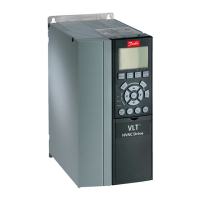
Do you have a question about the Danfoss FC 100 Series and is the answer not in the manual?
| Brand | Danfoss |
|---|---|
| Model | FC 100 Series |
| Category | Media Converter |
| Language | English |
Details Danfoss's copyright, limitation of liability, and revision rights for the manual.
Lists related Danfoss documentation for VLT HVAC Drives, including operating instructions and design guides.
Provides a table of abbreviations and standards used within the VLT HVAC Drive manual.
Explains how to identify the frequency converter using its identification label and type code.
Explains the type code string for low and medium power VLT HVAC Drives.
Explains the meaning of various symbols used in the manual for warnings and notes.
Highlights the dangers of high voltage and essential safety precautions during installation and operation.
Provides crucial safety notes and emphasizes compliance with national/local regulations.
Details essential steps to take before commencing any repair work on the frequency converter.
Discusses special conditions like single-phase or high-temperature applications affecting electrical ratings.
Safety considerations for installing the unit at high altitudes, including PELV requirements.
Outlines procedures to prevent accidental motor starts during operation or parameter changes.
Details the Safe Stop functionality and its requirements for safety category compliance.
Specific warnings and recommendations for connecting frequency converters to IT mains supplies.
Provides guidance on the proper disposal of electrical and electronic waste.
Covers initial checks and preparation steps before beginning mechanical installation.
A checklist to ensure the unit is undamaged and complete upon unpacking.
Illustrations showing the front views of various frequency converter enclosure types.
Detailed table of mechanical dimensions for different enclosure types and sizes.
Details the contents of the accessory bags included with the frequency converter.
Provides instructions and guidelines for the mechanical mounting of the frequency converter.
Highlights critical safety precautions that must be followed during mechanical installation.
Offers recommendations for mounting the frequency converter in field applications.
Information on panel through mounting kits and the procedure for installation.
General notes on cabling compliance, terminal tightening torques, and cable types.
Diagrams illustrating electrical installation and control cable connections, including terminal details.
Guidance on fuses for short-circuit and over-current protection according to regulations.
Details on proper earthing procedures and specific warnings for IT Mains connections.
An overview of mains wiring configurations based on different enclosure types.
Step-by-step instructions for connecting mains power to A2 and A3 enclosures.
Instructions for connecting mains power to A4 and A5 enclosures.
Details on connecting mains power to B1, B2, and B3 enclosures.
Instructions for connecting mains power to B4, C1, and C2 enclosures.
Details on connecting mains power to C3 and C4 enclosures.
Introduction to motor connection procedures, including cable requirements and precautions.
An overview of motor wiring configurations for different enclosure types.
Step-by-step motor connection instructions for A2 and A3 enclosures.
Motor connection details for A4 and A5 enclosures.
Motor connection details for B1 and B2 enclosures.
Motor connection details for B3 and B4 enclosures.
Motor connection details for C1 and C2 enclosures.
Motor connection details for C3 and C4 enclosures.
An example of wiring and testing the motor connection.
Instructions for connecting the DC bus for backup power supply.
Details on how to connect a brake resistor for braking functions.
Information and diagrams for connecting relay outputs.
Description of the functions for relay outputs and their terminal assignments.
Instructions on how to access the control terminals on the frequency converter.
Reference numbers for control terminals, including digital I/O, RS-485, and analog connections.
Steps for testing the motor connection and verifying its rotation direction.
Details on configuring switches for analog input modes and bus termination.
Guides the user through the initial setup and commissioning process.
Step-by-step instructions for setting parameters using the Quick Menu mode.
Instructions for connecting the frequency converter to a controller via RS-485.
Details on connecting a PC and using software tools for configuration and programming.
Provides useful tips for optimizing HVAC applications and parameter setup.
Method for quickly backing up and transferring parameter settings using the GLCP.
Procedures for resetting the frequency converter to its default factory settings.
Configuration example for basic motor start and stop functionality.
Configuration example for pulse-based motor start and stop.
Explanation of the AMA feature for optimizing motor performance and its limitations.
Outlines the three primary methods for operating the frequency converter.
A comprehensive guide to operating the Graphical Local Control Panel (GLCP).
A guide on operating the Numeric Local Control Panel (NLCP).
Step-by-step instructions for accessing and using the Function Set-ups menu.
Explains how to navigate and utilize the Main Menu for parameter configuration.
Procedures for changing numerical and text-based parameter data.
Guidance on reading and programming indexed parameters within the interface.
Detailed explanations and functions of commonly used parameters.
Overview of parameter groups, their titles, and functions.
Parameters related to operating states, display settings, and LCP configuration.
Parameters for configuring motor data, load settings, and automatic adaptation.
Parameters related to configuring brake functions, including DC brake and energy monitoring.
Parameters for setting reference limits, ramp times, and jog speeds.
Parameters for configuring operational limits, warnings, and speed bypass functions.
Parameters for configuring digital inputs, outputs, relays, and pulse signals.
Parameters for configuring analog inputs and outputs, including scaling and live zero settings.
Parameters for setting up communication protocols like Profibus, CAN, and LonWorks.
Specific parameters for configuring the Profibus communication interface.
Parameters for configuring the CAN Fieldbus communication.
Parameters for configuring the LonWorks communication.
Parameters for configuring the Smart Logic Controller (SLC) for custom logic.
Parameters for special functions like switching frequency, auto-derating, and energy saving.
Parameters for reading drive information such as operating hours and serial numbers.
Parameters used for reading various drive status and measurement data.
Parameters for accessing maintenance logs, fault logs, and input/output values.
Parameters for configuring the PI(D) controller for closed-loop operation.
Parameters for configuring extended closed-loop PI(D) controllers.
Parameters for various application-specific functions like no-flow and dry pump detection.
Parameters related to time-based functions, maintenance, and energy logging.
Parameters for additional application functions, including fire mode and multi-motor functions.
Parameters for configuring and monitoring the cascade pack controller.
Parameters for configuring the Analog I/O Option MCB 109.
Guidance on identifying alarms and warnings via LEDs and display codes.
A detailed list of fault messages, their causes, parameter references, and troubleshooting steps.
Troubleshooting steps to resolve issues related to motor noise or vibration.
Provides general technical specifications including mains supply, output current, and input current.
Details special conditions like derating for altitude, temperature, and low speed.
Guidance on derating the frequency converter's output based on ambient temperature.
Explains how the frequency converter automatically adjusts for performance.
Information on derating output current due to low air pressure and altitude.
Considerations for derating when operating the motor at low speeds.
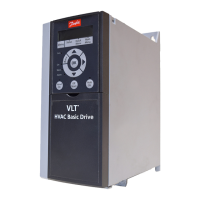
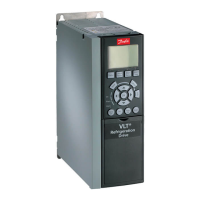
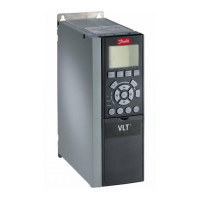
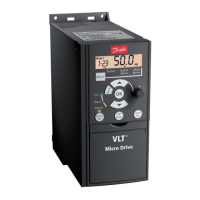
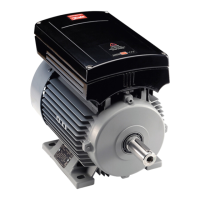
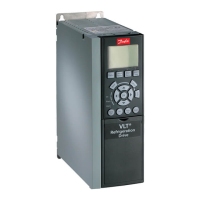
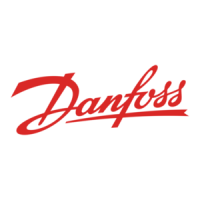
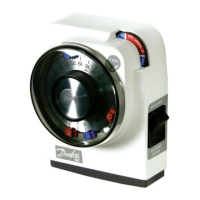
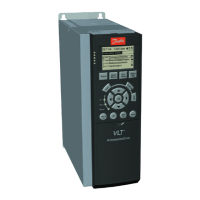

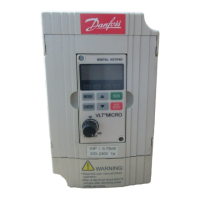
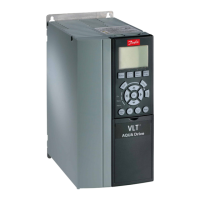
